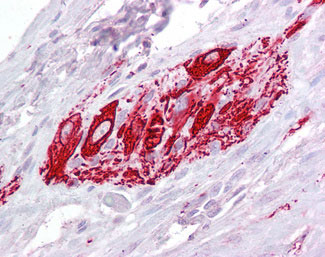ABRI / ITM2B Antibody (Internal)
Goat Polyclonal Antibody
- SPECIFICATION
- CITATIONS
- PROTOCOLS
- BACKGROUND

Application
| WB, IHC-P, E |
|---|---|
| Primary Accession | Q9Y287 |
| Reactivity | Human, Monkey, Horse, Bovine |
| Host | Goat |
| Clonality | Polyclonal |
| Calculated MW | 30kDa |
| Dilution | ELISA (1:8000), IHC-P (2.5-3.75 µg/ml), WB (1-3 µg/ml) |
| Gene ID | 9445 |
|---|---|
| Other Names | Integral membrane protein 2B, Immature BRI2, imBRI2, Protein E25B, Transmembrane protein BRI, Bri, BRI2, membrane form, Mature BRI2, mBRI2, BRI2 intracellular domain, BRI2 ICD, BRI2C, soluble form, Bri23 peptide, Bri2-23, ABri23, C-terminal peptide, P23 peptide, ITM2B, BRI, BRI2 |
| Target/Specificity | Human ITM2B. |
| Reconstitution & Storage | Store at -20°C. Minimize freezing and thawing. |
| Precautions | ABRI / ITM2B Antibody (Internal) is for research use only and not for use in diagnostic or therapeutic procedures. |
| Name | ITM2B |
|---|---|
| Synonyms | BRI, BRI2 |
| Function | Plays a regulatory role in the processing of the amyloid-beta A4 precursor protein (APP) and acts as an inhibitor of the amyloid-beta peptide aggregation and fibrils deposition. Plays a role in the induction of neurite outgrowth. Functions as a protease inhibitor by blocking access of secretases to APP cleavage sites. Bri23 peptide prevents aggregation of APP amyloid-beta protein 42 into toxic oligomers. |
| Cellular Location | [Integral membrane protein 2B]: Golgi apparatus membrane; Single-pass type II membrane protein Note=Immature BRI2 (imBRI2) is cleaved by furin in the Golgi into mBRI2 and a Bri23 peptide. mBRI2 is transported to the plasma membrane and Bri23 peptide is secreted [Bri23 peptide]: Secreted. Note=Detected in the cerebral spinal fluid (CSF). |
| Tissue Location | Ubiquitous. Expressed in brain. |
| Volume | 50 µl |

Thousands of laboratories across the world have published research that depended on the performance of antibodies from Abcepta to advance their research. Check out links to articles that cite our products in major peer-reviewed journals, organized by research category.
info@abcepta.com, and receive a free "I Love Antibodies" mug.
Provided below are standard protocols that you may find useful for product applications.
Background
Plays a regulatory role in the processing of the beta- amyloid A4 precursor protein (APP) and acts as an inhibitor of the beta-amyloid peptide aggregation and fibrils deposition. Plays a role in the induction of neurite outgrowth. Functions as a protease inhibitor by blocking access of secretases to APP cleavage sites. Bri23 peptide prevents aggregation of APP beta-amyloid protein 42 peptide into toxic oligomers.
References
Vidal R.,et al.Nature 399:776-781(1999).
Vidal R.,et al.Proc. Natl. Acad. Sci. U.S.A. 97:4920-4925(2000).
Ren S.,et al.Submitted (JAN-2001) to the EMBL/GenBank/DDBJ databases.
Hu R.-M.,et al.Proc. Natl. Acad. Sci. U.S.A. 97:9543-9548(2000).
Kalnine N.,et al.Submitted (MAY-2003) to the EMBL/GenBank/DDBJ databases.
If you have used an Abcepta product and would like to share how it has performed, please click on the "Submit Review" button and provide the requested information. Our staff will examine and post your review and contact you if needed.
If you have any additional inquiries please email technical services at tech@abcepta.com.













 Foundational characteristics of cancer include proliferation, angiogenesis, migration, evasion of apoptosis, and cellular immortality. Find key markers for these cellular processes and antibodies to detect them.
Foundational characteristics of cancer include proliferation, angiogenesis, migration, evasion of apoptosis, and cellular immortality. Find key markers for these cellular processes and antibodies to detect them. The SUMOplot™ Analysis Program predicts and scores sumoylation sites in your protein. SUMOylation is a post-translational modification involved in various cellular processes, such as nuclear-cytosolic transport, transcriptional regulation, apoptosis, protein stability, response to stress, and progression through the cell cycle.
The SUMOplot™ Analysis Program predicts and scores sumoylation sites in your protein. SUMOylation is a post-translational modification involved in various cellular processes, such as nuclear-cytosolic transport, transcriptional regulation, apoptosis, protein stability, response to stress, and progression through the cell cycle. The Autophagy Receptor Motif Plotter predicts and scores autophagy receptor binding sites in your protein. Identifying proteins connected to this pathway is critical to understanding the role of autophagy in physiological as well as pathological processes such as development, differentiation, neurodegenerative diseases, stress, infection, and cancer.
The Autophagy Receptor Motif Plotter predicts and scores autophagy receptor binding sites in your protein. Identifying proteins connected to this pathway is critical to understanding the role of autophagy in physiological as well as pathological processes such as development, differentiation, neurodegenerative diseases, stress, infection, and cancer.



